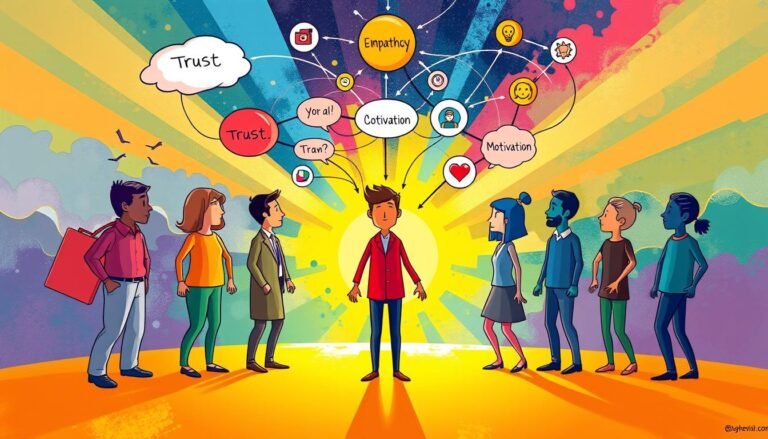How Team Leadership Impacts Organizational Behavior: A Psychological Guide
Ever wondered why some teams do great while others struggle, even in the same place? The answer often comes down to team leadership’s subtle yet strong impact on how teams behave.
Leadership is key in shaping an organization’s psychological atmosphere. It’s like a compass that guides how engaged employees are, how teams work together, and how well they perform. In this guide, we’ll explore how good leaders make places where new ideas grow and people feel important.
Recent studies show us how team leadership affects us. A Gallup poll found that only three out of ten workers feel heard at work. This shows how crucial leaders are in making sure everyone feels safe and can share their thoughts.
A Google study in 2015 found that teams that feel safe are more creative and do better. This shows a clear link between leadership, team behavior, and success.
Key Takeaways
- Team leadership greatly affects how teams behave and perform.
- Good leaders make safe spaces for their teams.
- Only 43% of people say their team is positive.
- Leaders who listen well make teams feel safer.
- Teams that feel safe are more innovative and do better.
- Fear stops many from speaking up, hurting teamwork.
Understanding the Role of Team Leadership in Organizations
Team leadership is key to an organization’s success. It shapes how teams work and perform. Let’s look at what makes a good team leader and how they impact the team and the organization.
Defining Team Leadership
Team leadership means guiding a group towards goals. Team leaders don’t always manage, but they guide and support. They focus on leading projects and work.
The Impact of Leadership on Organizational Dynamics
Good team leadership changes how an organization works. Leaders with a clear vision help everyone stay focused. This leads to better work and following the company’s goals.
- Happy employees
- More motivation
- Keeping employees longer
- Better performance
Key Responsibilities of Team Leaders
Team leaders do important things for the organization:
| Responsibility | Description |
|---|---|
| Communication | Telling goals, giving context, and getting feedback |
| Organization | Setting up work and aligning resources with goals |
| Delegation | Giving tasks and helping team members grow |
| Problem-solving | Fixing big problems to keep goals on track |
| Time management | Managing work to meet goals |
By doing these things, team leaders help teams work better. They also celebrate wins, keeping everyone motivated.
The Psychological Foundation of Effective Team Leadership
Leadership psychology is key to managing teams well. It’s about understanding people and what motivates them. The self-determination theory is important here. It says that meeting basic needs leads to the best team performance.
Emotional intelligence is vital for leaders. Leaders with high emotional intelligence handle team dynamics well. They manage their feelings and those of their team. This builds strong team bonds and a supportive work place.
Studies show that psychological safety is crucial for team success. Google’s Project Aristotle in 2012 found it essential. Amy Edmondson, who first talked about it in 1999, says it’s key for open communication and creativity.
“Psychological safety evolves through four stages: inclusion safety, learner safety, contributor safety, and challenger safety.”
Leaders who focus on psychological safety make a safe space. Here, team members feel free to share, take risks, and question things. This meets the self-determination theory’s needs for autonomy, competence, and connection.
- Demonstrate vulnerability and openness
- Encourage open dialogue
- Conduct regular check-ins
- Lead constructive feedback sessions
- Empower team members
By using leadership psychology, emotional intelligence, and self-determination theory, leaders can build strong teams. These teams are innovative and adaptable in today’s fast-changing business world.
Team Leadership Styles and Their Effects on Behavior
Leadership styles are key in shaping team behavior and success. Different styles can inspire, motivate, or slow down teams. Let’s look at four main leadership styles and how they affect team dynamics.
Transformational Leadership
Transformational leaders inspire teams to do more than expected. They focus on new ideas and progress. This style boosts creativity and keeps teams improving.
Servant Leadership
Servant leaders care most about their team’s growth and happiness. They put their team first, making a supportive space. This builds strong, dedicated teams and promotes trust.
Authoritative Leadership
Authoritative leaders give clear directions and high standards. While good in some cases, it might stifle creativity. It’s best when quick decisions are needed or in emergencies.
Democratic Leadership
Democratic leaders encourage teamwork and involve everyone in decisions. This style boosts creativity and engagement. It makes sure everyone feels important and heard.
| Leadership Style | Key Characteristics | Impact on Team Behavior |
|---|---|---|
| Transformational | Inspiring, innovative | Increased motivation, creativity |
| Servant | Supportive, empathetic | Strong loyalty, personal growth |
| Authoritative | Directive, goal-oriented | Clear focus, possible reduced creativity |
| Democratic | Collaborative, inclusive | High engagement, shared ownership |
Choosing the right leadership style depends on the team, goals, and situations. Good leaders adjust their style to fit changing needs and improve team performance.
Creating a Positive Team Climate Through Leadership
Leaders are key in shaping a team’s climate. A good work environment boosts productivity and makes employees happy. Let’s look at how leaders can create a safe, open, and respectful team.
Fostering Psychological Safety
Psychological safety is vital for team success. When team members feel safe to share ideas, innovation grows. Leaders who make this happen see a 35% boost in creativity.
Encouraging Open Communication
Open communication is essential for a healthy team. Leaders who are transparent see better teamwork and trust. In fact, 78% of employees are more motivated when leaders share their vision and goals clearly.
Building Trust and Mutual Respect
Trust and respect are the base of strong teams. Leaders who lead by example earn more respect, with 92% of employees preferring them. This approach positively affects the whole organization.
| Leadership Action | Impact on Team Climate | Percentage |
|---|---|---|
| Clear Communication | Increased Motivation | 78% |
| Leading by Example | Employee Preference | 92% |
| Fostering Psychological Safety | Boost in Innovation | 35% |
By focusing on these areas, leaders can build a team climate that supports growth and success. Remember, a positive team starts with leadership commitment to open communication and safety.
The Impact of Team Leadership on Employee Engagement
Team leadership is key in boosting employee engagement, motivation, and job satisfaction. Studies show leaders greatly impact team performance and company success.
A 2020 study by Rahmadani and Schaufeli found that engaging leaders boost work engagement in employees. This supports the Job Demands-Resources model, which highlights the need for job balance to foster engagement.
Employee engagement is vital. Gallup’s research shows only 23% of employees worldwide are engaged. This means about 3 out of 4 workers are not fully committed. This lack of engagement could cost the global economy around 7.8 trillion dollars each year.
Effective team leaders create a supportive work environment. They focus on:
- Providing recognition for employee achievements
- Empowering team members to make decisions
- Offering opportunities for growth and development
Leaders who focus on these areas see higher job satisfaction and motivation. A 2012 study by Rego et al. found that authentic leadership boosts employees’ psychological capital and creativity. This increases engagement levels.
“Up to 70% of an employee’s engagement variance depends on their leader.” – Gallup
This statistic shows how crucial team leaders are in building an engaged culture. By using effective leadership strategies, companies can fight trends like “Quiet Quitting.” This boosts productivity and job satisfaction.
Conflict Resolution and Team Leadership
Conflict resolution is key in team leadership. Good leaders face team conflicts head-on, seeing them as chances for growth. Let’s look at how to manage conflicts in teams.
Identifying Sources of Conflict
Team conflicts come from many places. These include discrimination, bad communication, different personalities, or goals. Spotting these early helps leaders solve problems before they get worse.
Strategies for Effective Conflict Management
Good conflict management means open talk and solving problems. Leaders should listen well, focus on the issue, and make clear plans. For remote teams, don’t use email for conflicts and keep schedules open.
Turning Conflicts into Opportunities
Conflicts are tough, but they also offer growth chances. The CPP Global Human Capital Report shows some good sides of workplace conflicts:
| Outcome | Percentage of Respondents |
|---|---|
| Better understanding of others | 41% |
| Improved working relationships | 33% |
| Better solutions to problems | 29% |
| Higher team performance | 21% |
| Increased motivation | 18% |
By using good conflict management, team leaders can create a better work place. This boosts productivity and innovation. Remember, solving conflicts fast keeps team bonds strong and encourages growth.
Team Leadership and Decision-Making Processes
Team leadership is key in making decisions in organizations. Good leaders involve their team in decisions. This makes everyone feel more responsible and committed to the results.
Studies show diverse teams solve problems quicker than similar groups. By working together, leaders can use everyone’s ideas. This leads to smarter decisions and better risk management.
Leaders need to act fast but also listen to their team. For example, Amazon’s Jeff Bezos makes quick decisions on some things. This helps the team learn and move forward without big risks.
“The responsibility assignment matrix (RACI) categorizes stakeholders into Responsible, Accountable, Consulted, and Informed roles for each task in order to streamline decision-making processes.”
Good leaders also make decisions based on data. They use analytics to make sure their choices are smart. This method works well in many areas, like sports and business.
In summary, team leadership greatly affects decision-making. By working together, using different ideas, and relying on data, leaders help their teams find better solutions.
Developing Emotional Intelligence in Team Leadership
Emotional intelligence is key for leaders. It’s more valued than technical skills, with 71% of employers preferring it. This shows how important it is for team leaders to have good interpersonal skills.
Self-awareness and Self-regulation
Self-awareness is the base of emotional intelligence. Though 95% think they know themselves well, only 10-15% really do. Leaders who get their emotions can manage their responses better, making a positive team atmosphere.
Empathy and Social Skills
Empathy is a big part of emotional intelligence. Leaders who are good at understanding others do 40% better in coaching and decision-making. This leads to better team work and results.
Motivating Team Members
Leaders with high emotional intelligence can motivate their teams well. They create a respectful and understanding environment, which 72% of employees say makes them happy at work.
| Aspect of Emotional Intelligence | Impact on Leadership |
|---|---|
| Self-awareness | Better decision-making and self-regulation |
| Empathy | Improved team engagement and coaching abilities |
| Social skills | Enhanced conflict resolution and team motivation |
Building emotional intelligence in team leadership is not just good—it’s crucial. It’s the best way to predict success and is key for teamwork. By working on these skills, leaders can greatly improve and help their teams succeed.
Team Leadership and Organizational Performance
Effective team leadership is key to boosting organizational performance. Leaders who inspire and guide their teams well can greatly increase productivity and success. Research shows that 50-70% of what employees think about their work comes from management’s actions.
Strong leaders create a positive work culture that boosts employee engagement and commitment. This leads to better profits for companies. Leaders also help teams adapt to change by communicating clearly and engaging stakeholders.
Leadership greatly affects how well an organization performs. Leaders who set clear goals and encourage innovation help teams work better. They also invest in training future leaders, which is vital for long-term success. In 2020-2021, over $92 billion was spent on training, showing the value of leadership development.
Effective leaders focus on both getting tasks done and taking care of their team. They build an inclusive workplace that values diversity and fairness. This creates a supportive environment where everyone can do their best for the organization.
Source Links
- Psychological safety and the critical role of leadership development
- Impact of Leadership on Team’s Performance
- Developing Leadership Skills in an Advanced Management Program
- 10 Things Great Team Leaders Do [2024] • Asana
- 4 Key Responsibilities Of Great Leadership Teams
- Psychological Safety is the Foundation of Strong Teams and Culture
- The Importance of Psychological Safety in Leadership
- Building Psychological Safety and a case for Team Effectiveness over Efficiency
- How Leadership Styles and Behavior Affects Team Members and Beyond
- How Leadership Styles Impact Teams | Hacking HR
- Exploring Behavior Leadership Theory and Approaches to Leadership
- The Role of Leadership in Creating a Positive Team Culture
- Leadership’s Role in Creating a Positive and Productive Team Culture
- The impact of engaging leadership on employee engagement and team effectiveness: A longitudinal, multi-level study on the mediating role of personal- and team resources
- Measuring the Impact of Leadership on Employee Engagement
- Leadership Guide to Conflict and Conflict Management
- Preventing and Managing Team Conflict – Professional & Executive Development | Harvard DCE
- Conflict Resolution in a Team: Leadership Lessons
- The decision-making process is a team sport
- Empowering Teams in Decision-Making: The Collaborative Leadership Approach
- 8-Step Leadership Decision-Making Process For Making The Best Decisions
- Emotional Intelligence in Leadership: Why It’s Important
- Building the Emotional Intelligence of Groups
- Does Leadership Impact organizational performance? – Highrise
- Strategies for Mastering Team Leadership | FranklinCovey
- How Leadership Affects Organizational Success – Business Leadership Today







